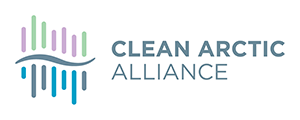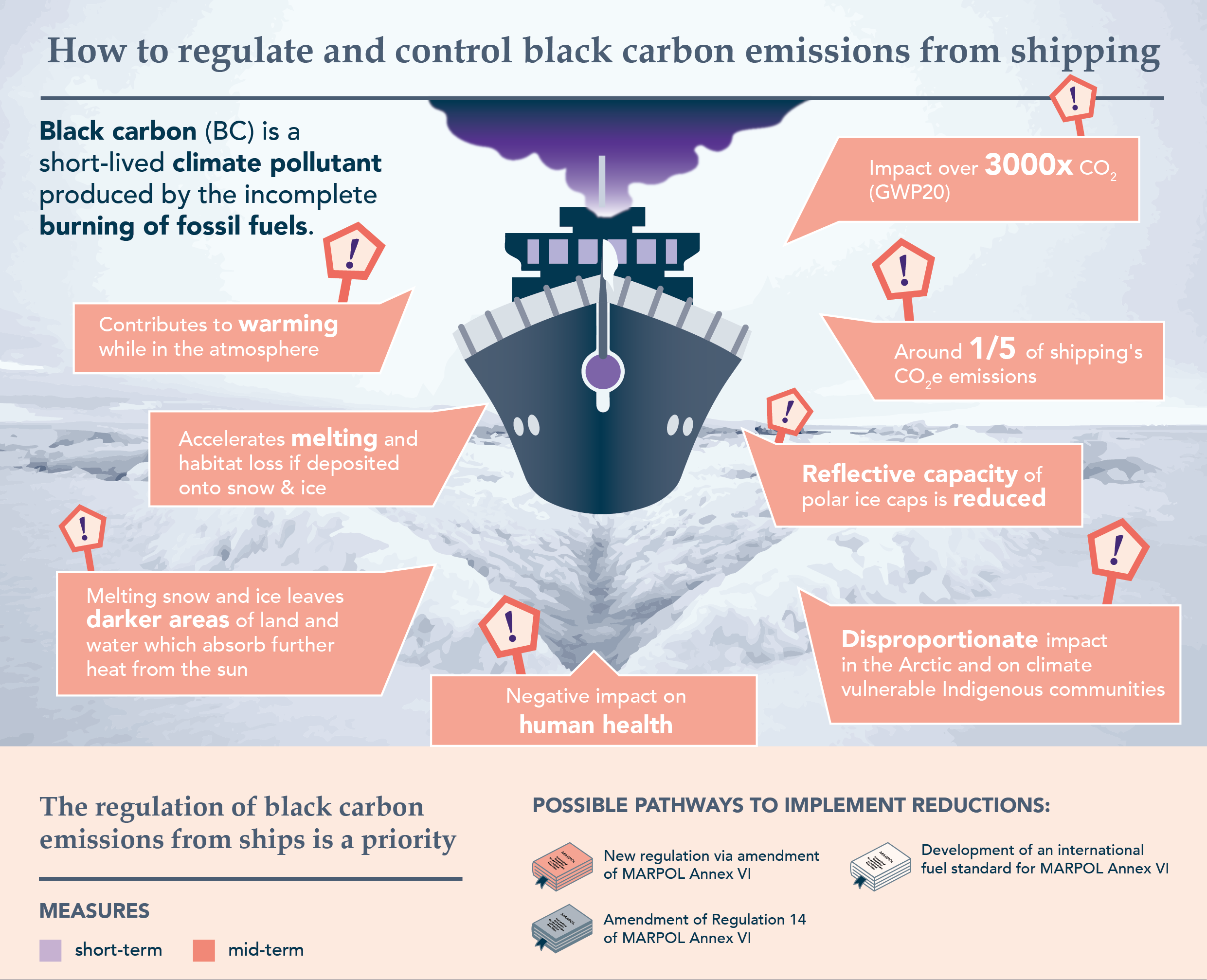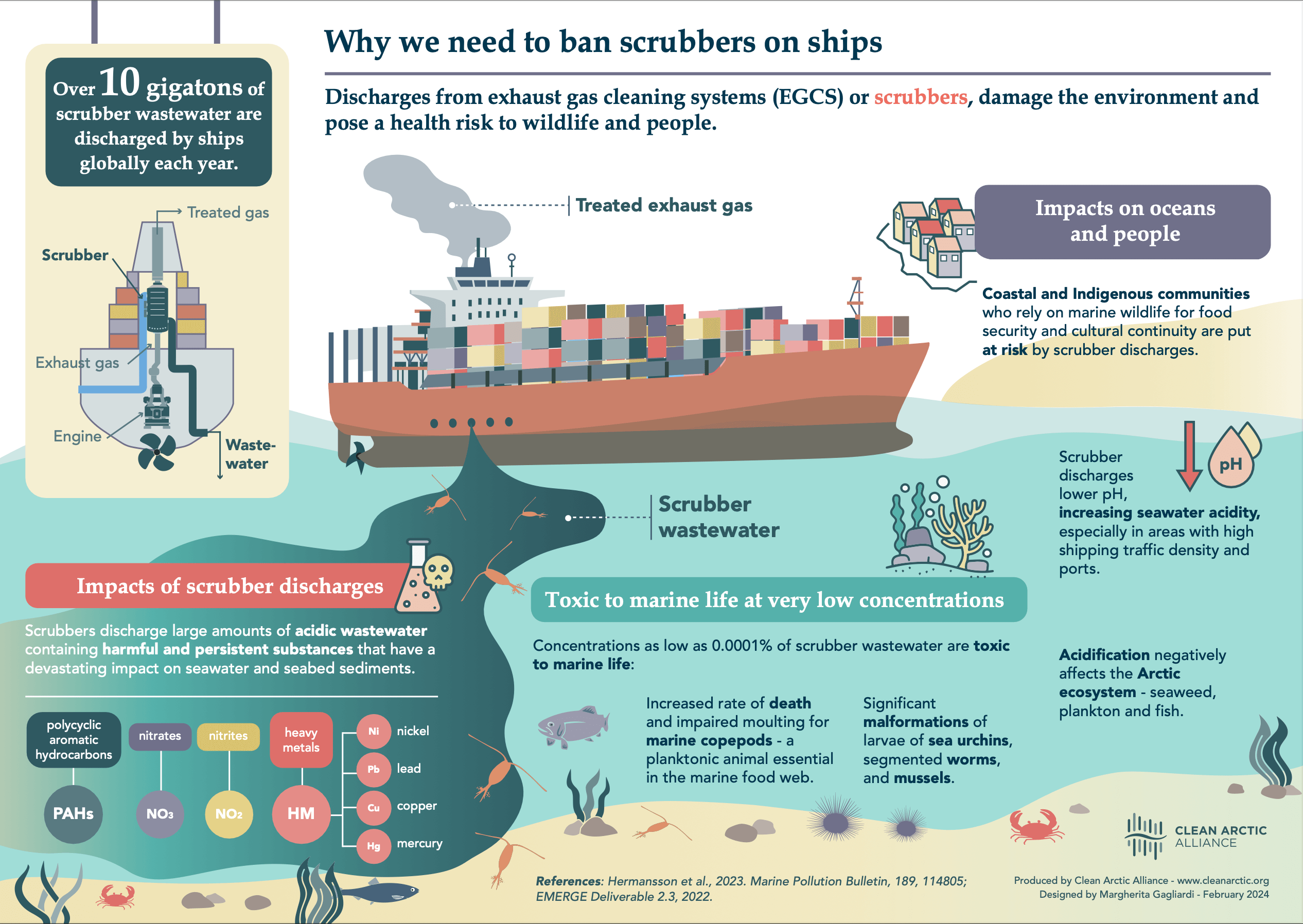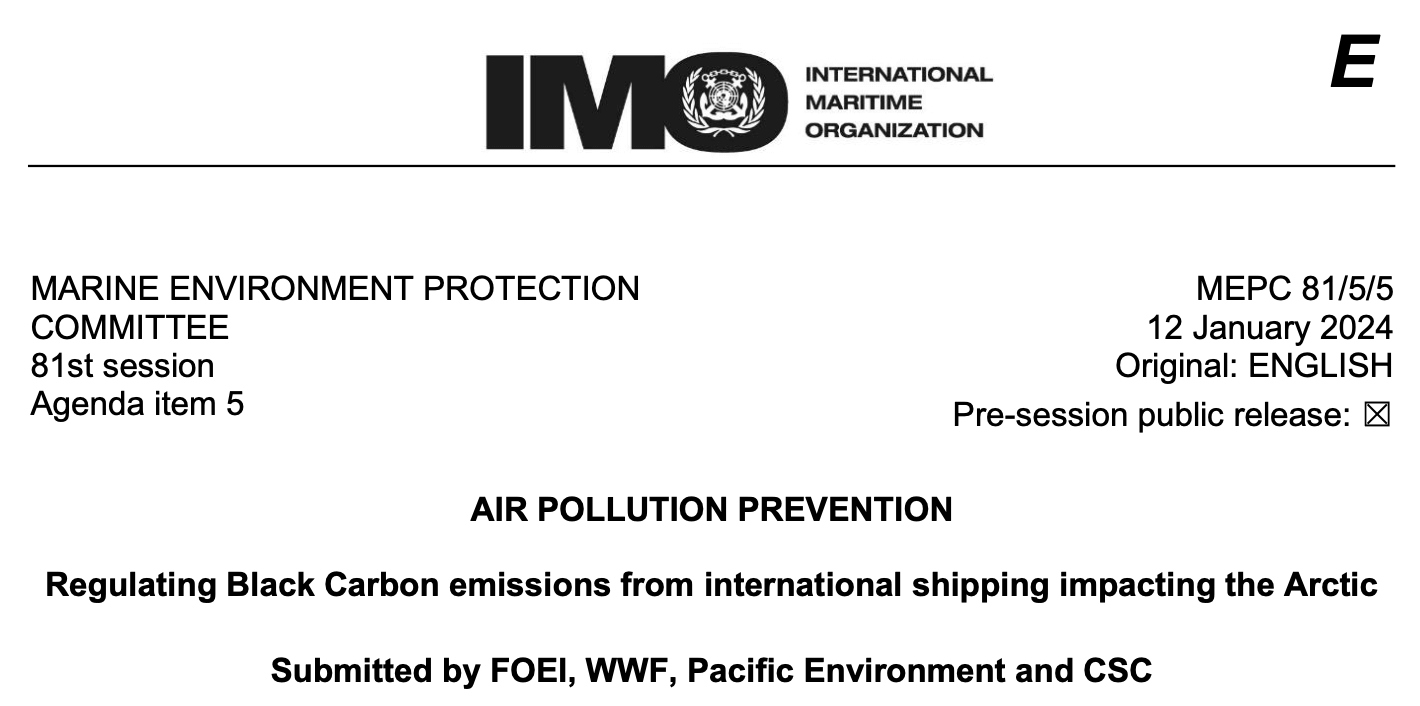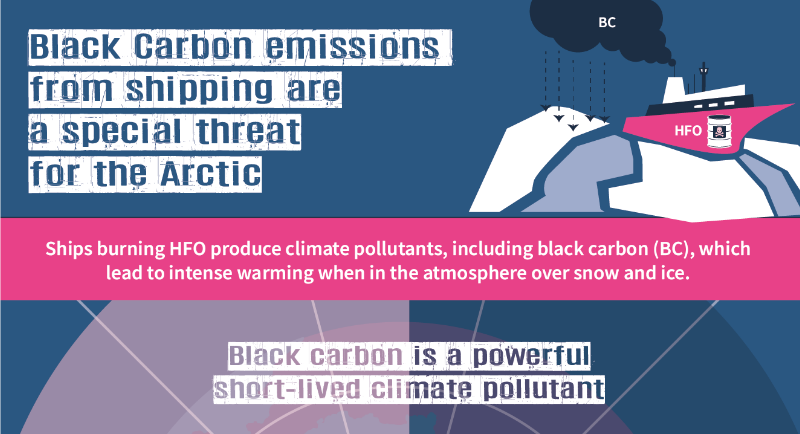
London, 18 November 2021:- As NGOs today called on the International Maritime Organization (IMO) to halve shipping emissions by 2030, ahead of next week’s meeting of the IMO’s Marine Environment Protection Committee (MEPC 77), Dr Sian Prior, Lead Advisor to the Clean Arctic Alliance, said:
“Next week, the IMO must tackle the impact of black carbon emissions on the Arctic, a short-lived climate forcer responsible for 20% of shipping climate impact. To achieve this, the IMO must urgently put in place strong measures to drive fast deep cuts to black carbon emissions from shipping operating in or near the Arctic, and to urgently reduce CO2 as well as black carbon emissions from the maritime sector globally”.
“A proposal for a resolution calling on ships operating in and near the Arctic to move from heavier, more polluting fuel oils to lighter distillate fuels has been submitted to MEPC 77 by eleven IMO Member States”, she added [1]. “If all shipping currently using heavy fuel oils while in the Arctic were to switch to distillate fuel, there would be an immediate reduction of around 44% in black carbon emissions from these ships. If ships also installed a particulate filter black carbon emissions could be reduced by over 90%”.
“The recent IPCC findings show that the levels of climate ambition and timelines currently on the table for shipping at the IMO are totally inadequate”, continued Prior. “It is imperative that measures due for adoption at the IMO’s Marine Environment Protection Committee (MEPC 77) be strengthened to ensure they drive fast deep cuts in CO2 and black carbon emissions from ships, especially those visiting or operating near the Arctic.”
Statement:
COP26 commitments mean IMO must halve shipping emissions by 2030
(November 18, 2021) – Recent IPCC reports and the developments at the COP26 Climate Summit in Glasgow are a wake-up call that the UN’s International Maritime Organization (IMO) cannot ignore. Countries must now build on their commitments to save the Paris Agreement’s 1.5° temperature goal with concrete action and halve shipping emissions by 2030 at the IMO.
There is currently no strategy in place at the IMO to achieve any significant ship emission reductions before 2030, let alone the reductions necessary to keep the sector on a pathway consistent with warming below 1.5°. Under the current IMO regulations ship emissions continue to rise out to 2030 and the shipping industry will exhaust its 1.5 degree carbon budget by 2029.
At next week’s 77th session of IMO’s Marine Environment Protection Committee (“MEPC77”), IMO member states must urgently align the agency’s work on reducing climate impacts from shipping with the COP26 developments.
In particular, countries have the opportunity to:
- Align shipping with the 1.5° degrees target: commit to reducing ship climate impacts on a timeframe consistent with keeping warming below 1.5°, including reaching zero by 2050 at the latest and halving emissions by 2030;
- Bolster short-term measures: reopen discussions on the level of ambition in the IMO’s short-term measure with a view to agreeing new targets consistent with halving emissions by 2030;
- Tackle black carbon: take decisive action to address the impact on the Arctic of black carbon emissions, a short-lived climate forcer responsible for 20% of shipping climate impact; and
- Set a GHG levy: agree a minimum $100/tonne levy on GHG emissions to raise climate finance and support a just transition to zero across the sector as called for at COP26.
These actions constitute a significant increase in the ambition of IMO’s climate work but they are necessary if we want the shipping industry to contribute to keeping global heating below 1.5° and save billions of people around the world from climate chaos.
The COP26 summit has already laid an important foundation for this shift, as:
- 54 climate-vulnerable countries signed the Dhaka-Glasgow declaration, demanding a carbon levy on ship fuel;
- 22 countries agreed to set up decarbonised shipping corridors through the Clydebank Declaration;
- 14 countries endorsed the Declaration on Zero Emission Shipping by 2050.
We applaud the signatories for their climate leadership and urge them to make their presence felt at MEPC77. We insist that they stick to their positions on aligning with the 1.5° temperature goal, thereby having to halve shipping emissions by 2030, and support a carbon levy inside the IMO as well as outside it.
We will continue monitoring closely the discussion at the IMO to make sure climate commitments at COP26 translate into concrete action.
This statement is issued by:
Clean Shipping Coalition: John Maggs – [email protected]
Clean Arctic Alliance: Sian Prior – [email protected]
Global Choices: Inge Relph – [email protected]
Seas at Risk: Lucy Gilliam – [email protected]
Opportunity Green: Aoife O’Leary – [email protected]
Pacific Environment: Jim Gamble – [email protected]
Greenpeace: Veronica Frank – [email protected]
WWF- Canada: Andrew Dumbrille – [email protected]
Environmental Defense Fund: Catherine Ittner – [email protected]
ECODES: Marina Gros – [email protected]
Background information:
On COP26:
55 Climate Vulnerable Forum countries (of which 47 are IMO member states) signed the Dhaka-Glasgow declaration, which includes a maritime segment supporting a greenhouse gas (GHG) levy, i.e. carbon price, that aligns shipping emissions with a 1.5° pathway at the IMO.
Of course, a 1.5° pathway, according to the IPCC, requires a 45% reduction in global emissions by 2030, and reaching zero overall emissions before 2050. This means the declaration carries explicit support for deep emission cuts this decade, a greenhouse gas levy, and implicit support for strengthening the zero emissions by 2050 goal.
22 countries signed the Clydebank Declaration to create “green corridors” for zero-carbon shipping by 2025. Making these shipping routes commercially viable will require either a significant carbon price of between $200-400/mt, or equivalent strength fuel standards incentivising immediate uptake of zero, not just low, carbon fuels.
14 countries signed the Declaration on Zero Emission Shipping by 2050: This brings the total to 49 countries supporting zero shipping emissions by 2050 (including 8 CVF Asia branch members who supported zero by 2050 in a statement in late September).
By adding the remaining CVF members, who as noted above have supported a 1.5° temperature goal that requires zero emissions by 2050, this brings the total number to 93 countries supporting climate-neutral shipping by 2050. This is a clear majority of the IMO’s total 175 member states.
On shipping:
Generally, around 90% of all traded goods are transported across oceans on cargo vessels, currently all powered by fossil fuels such as heavy fuel oil. The IMO estimates that shipping currently accounts for almost 3% of all global greenhouse gas emissions. Researchers warn that by 2050 this could well represent up to 10% of all emissions.
The sector also produces up to 15% of the world’s manufactured sulfur oxide and nitrous oxide emissions, which disproportionately impact low income communities of color living near ports. As a result, shipping emissions are linked to an estimated 6.4 million global childhood asthma cases and 260,000 premature deaths annually.
On black carbon:
Black carbon (BC) is a powerful, short-lived climate pollutant which has a disproportionate impact when emitted in or near the Arctic. BC emissions from Arctic shipping increased 85% between 2015 and 2019. Action to reduce BC emissions will improve human health as well as mitigate climate change. As a first step to tackling this problem at MEPC77, IMO Members should adopt a Resolution on BC urging voluntary use of distillate fuel with low aromaticity by ships operating in and near to the Arctic.Contacts:
Dave Walsh, Clean Arctic Alliance Communications Advisor [email protected] +34 691 826 764
Notes:
About the Arctic and Black Carbon
Major shifts in climate occur more strongly and proceed faster at high latitudes with the most dramatic changes seen in the sea-ice cover of the Arctic Ocean. The summer sea ice cover is much reduced compared to only a few decades ago, and the remaining ice is about half as thick. Multi-year ice has declined by around 90%. Days with no summer sea ice could come as soon as the early 2030s, if the world fails to fulfil the Paris Climate Agreement’s commitment to limit global heating to less than 1.5C, which could have unprecedented consequences for the global climate and marine environment.
Arctic shipping is increasing as reduced sea ice opens up access to resources, and interest in shorter trans-Arctic shipping routes grows. Despite global efforts, ships’ black carbon emissions are rising – black carbon emissions from shipping in the Arctic increased 85% between 2015 and 2019. When black carbon settles onto snow and ice, melting accelerates, and the loss of reflectivity creates a feedback loop exacerbating global heating. Black Carbon also has health impacts for Arctic communities. Reductions in black carbon emissions from shipping in or near the Arctic can be introduced rapidly by switching to cleaner fuels and have an immediate impact in reducing melting of snow and ice since the black carbon is short-lived and remains in the atmosphere for only days or weeks.
For more information, see the follow infographics:
How Black Carbon Emissions from Shipping Impact The Arctic
https://www.hfofreearctic.org/en/2021/03/08/black-carbon-facts/
Infographic: Urgent and immediate action needed to cut black carbon emissions from ships https://www.hfofreearctic.org/en/2020/02/12/infographic-urgent-and-immediate-action-needed-to-cut-black-carbon-emissions-from-ships/
[1] MEPC 77-9 – Comments on the outcome of PPR 8
About the Clean Arctic Alliance
Made up of 21 not-for-profit organisations, the Clean Arctic Alliance campaigns to persuade governments to take action to protect the Arctic, its wildlife and its people.
Members include: 90 North Unit, The Altai Project, Alaska Wilderness League, Bellona, Clean Air Task Force, Green Transition Denmark, Ecology and Development Foundation ECODES, Environmental Investigation Agency, Friends of the Earth US, Global Choices, Greenpeace, Iceland Nature Conservation Association, International Cryosphere Climate Initiative, Nature And Biodiversity Conservation Union, Ocean Conservancy, Pacific Environment, Seas At Risk, Surfrider Foundation Europe, Stand.Earth, Transport & Environment and WWF.
More more information visit https://www.cleanarctic.org/
Twitter: https://twitter.com/CleanArctic
